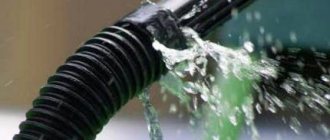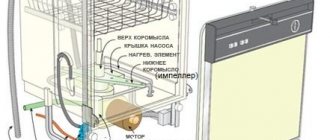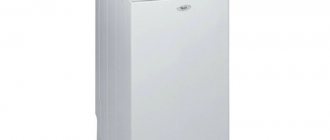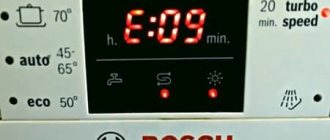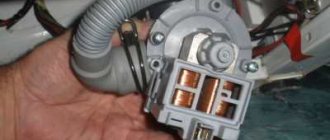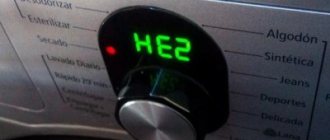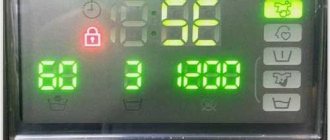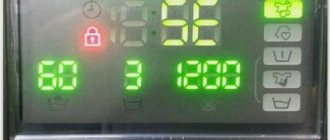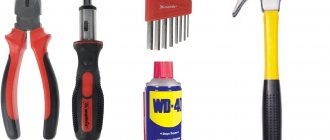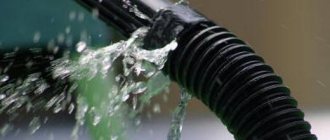Whirlpool brand appliances, which are manufactured in America, have been helping to maintain cleanliness and order in homes around the world for more than half a century. Dishwashers (DMM) from this company are in particular demand. Their build quality is at the highest level. Despite this, sometimes users encounter problems and breakdowns. It is not always possible to decipher Whirlpool dishwasher error codes using the instructions. Find out everything about how to determine the nature of the problem and fix it yourself.
Whirlpool dishwasher - error codes
Whirlpool brand appliances, which are manufactured in America, have been helping to maintain cleanliness and order in homes around the world for more than half a century. Dishwashers (DMM) from this company are in particular demand. Their build quality is at the highest level. Despite this, sometimes users encounter problems and breakdowns. It is not always possible to decipher Whirlpool dishwasher error codes using the instructions. Find out everything about how to determine the nature of the problem and fix it yourself.
Service area
Service is constantly expanding the geography of its activities. The company offers on-site repair services for washing machines, dryers, dishwashers, refrigerators, ovens and electric stoves in Moscow, the Moscow region, New Moscow, Odintsovo, Elektrostal, Troitsk, Domodedovo, Dmitrov.
- After our technicians, your household appliances will delight their owners with impeccable performance for a long time to come. Contact us and we will do our best to restore your unit as quickly as possible. The client is satisfied - “Stir-Repair” is calm.
Dishwasher won't start
Any user can encounter this problem. Startup errors often occur due to improper operation, manufacturing defects, and wear of key parts. The code on the display will help you find the cause of the problem. Here are the most common ones.
- A breakdown of one of the pumps that drains water. Water remains in the working tank of the PMM. Arises from wear and tear of this equipment.
- Violation of the Whirlpool dishwasher operating instructions. This category includes errors such as exceeding the maximum permissible weight of loaded dishes, or breaking the seal during operation (the door was not fully closed).
- Formation of leaks in pipes and other elements of the PMM water supply system.
- Low quality of detergents and cleaning products used. Find out which household chemical manufacturers your dishwasher manufacturer recommends. If you save on these products, the inevitable repairs or purchase of new equipment will cost much more.
- Weak water pressure. This may be caused by installation errors or malfunctions of the water supply system in your home.
- There are problems with the power supply to the device. Damaged power cord, broken socket.
- Dishwasher wiring problems. This leads to a short circuit and failure of the heating element.
- Damage to the central control module. The most common cause of this type of malfunction is power surges.
- The filter is clogged with food debris. Before washing dishes in a PMM, remove uneaten food from its surface. Check the filter for contamination at least once every six months.
Check the drain hose and drain.
As a last option, the pump is diagnosed and replaced. The unit is located in conjunction with a circulation pump. Turn off the wiring, turn the pump clockwise and install a new part.
Heating does not work
Having loaded the dishes and started the program, the PMM stops working. Or the cycle is carried out without heating. What is the reason:
The problem may be a faulty heating element or temperature sensor. The first one suffers from scale. If heating takes longer than usual, the part is probably covered with plaque, which interferes with heat transfer. It is possible to remove scale, but repairing a burnt heating element is not.
Error codes
The presence of a display on the dishwasher helps in displaying the error code that occurs. But among the rich assortment of Whirlpool there are models that are not equipped with a display. Although all error messages are standardized, there are quite a few different options for displaying them. The code can be displayed on the display using numbers and letters, indicated by flashing or lighting of indicators on the front panel.
Whirlpool error codes are divided into two large subgroups:
About the brand
An American company that was born as a result of the merger of two small companies producing household appliances in 1950. In 1970, the company's engineers invented a machine for packaging waste, and as a result, the company began mass-producing them. At the moment, the corporation is the world's largest manufacturer of large household appliances and is actively buying up competing companies. In particular, in 2014, the company bought a controlling stake in Indesit (Ariston, Hotpoint Ariston).
"E" error codes
This type of error will appear on the display as E. On devices equipped only with LED indicators, the code will be displayed using sequential ignition and dimming of the front panel lamps. Their number may vary from model to model. For convenience, we will use the most common number of indicators – five. The serial numbers of the lit LEDs will be located in brackets next to the alphanumeric code.
- E1 (1, 5) – excess liquid in the sump, activation of the Aquastop emergency system. Occurs when the sensor detects a leak at the pipe connection. This may also indicate a malfunction of the sensor itself. If water is actually in the sump, we can confidently talk about wear of gaskets, seals, and damage to pipes. Independent replacement is possible, but requires specialized tools in order to disassemble the PMM body.
- E2 (2, 5) – blocking of all device systems. There are problems with electrical wiring or other systems that may pose a possible hazard if you continue to use your Whirlpool dishwasher. For more detailed diagnostics, contact the service center.
- E3 (1, 2, 5) – error in the water heating system. Problems of this type include failure of the heating element (scale, wiring) and electronic temperature sensor. The faulty element must be replaced.
- E4 (3, 5) – temperature sensor failure. The most common reason is a voltage drop in the network. Such electronics are extremely sensitive to them. Replace the broken part with a new one.
- E5 (1, 3, 5) – excessively long collection of water into the working tank. The cause of this problem may be a closed water intake valve, a broken magnetic valve, the presence of foreign objects in the intake hose, or incorrect pressure sensor readings. First of all, check whether water enters the system: open the valve and check the integrity and permeability of the hose through which water enters the machine. Clean the filter from dirt. Inspect the solenoid valve. Check the pressure switch pipe for blockages.
- E6 (2, 3, 5) – problems with the waste water drainage system. Occurs due to a blockage in the drain system (drain hose, filter), failure of the drain pump. Clean the hose, filter, and pump cavities. Check the pump's functionality. If a breakdown is detected, replace it.
How to turn on and start the equipment:
If after this the PMM does not restore operation, you need to look for the problem.
The problem is that the drain filter is clogged. To clean it:
If the spray arms do not rotate or water does not flow through the nozzles, do this:
How to disassemble the housing and install a new engine:
The engine is in your hands. Now install the new unit in reverse order. Details of the repair are in the video:
Waste water does not go down the drain
In time the washing was over, but in fact the tank was full of water. Why doesn't the liquid drain? A typical problem is blockage. Poor cleaning of dishes before loading, or the entry of food residues into the tract lead to blocking of the drain system.
We described above how to clean the filter. Behind it is the pump impeller, which is blocked by foreign objects. Put on gloves and clean the impeller of foreign objects. Be careful as there are often broken pieces of crockery in the hole.
"F" error codes
Error codes of this type will appear on the dishwasher display as F. After F there must be a character from the hexadecimal number system (0-9, AE). Not all PMMs are equipped with a display. In such models, the value after F will be determined by the blinking of the START indicator. Their number will be indicated in brackets.
- F0 (10) – contamination sensor malfunction. An error can occur in cases where the sensor is heavily dirty, sends an incorrect signal to the control unit, the signal itself is completely absent, or there is a malfunction in the control unit. It is almost impossible to diagnose such electrical equipment at home; seek help from specialists. The faulty sensor or controller is replaced with a new one.
- F1 (1) – the temperature sensor returns an incorrect value to the central control unit. After inspection, it is replaced with a new one.
- F2 (2) – a water leak has been detected, accumulating in the pan. The problem may be in the water supply or drainage system. Also check the integrity of the working tank itself. After detecting a leak, seal it, replace damaged gaskets and pipes.
- F3 (3) – error in the heating system. This code may be a consequence of failure of the heating element or temperature sensor (thermistor). The service center diagnoses all electrical components of this system. After this, the faulty elements are replaced.
- F4 (4) – water is not removed from the dishwasher after operation. A blockage in the drainage system, failure of the pump that is responsible for pumping out water, damage to the wiring. Clean the filter and hose, diagnose the pump systems. Replace faulty parts.
- F5 (5) – movement of the water sprayer is difficult or impossible. This occurs due to improper loading of dishes, exceeding the maximum permissible volume, or foreign objects getting into the sprinkler. Carefully inspect the part and the space around it. Remove all utensils if necessary. Do a test run. If this does not help, contact the Whirlpool service center.
- F6 (6) – malfunction of the water intake system. The inlet valve, valve, water flow sensor have failed, and a blockage has formed in the intake hose. Clean all elements of the system from debris and blockages. Replace the faulty sensor.
- F7 (7) – the flow sensor transmits incorrect data, the control unit does not respond to the request. Conduct diagnostics of the sensor itself, as well as adjacent wiring. Install a new sensor if necessary.
- F8 (8) – insufficient amount of liquid in the dishwasher tank. This code is displayed if too much foam has formed in the tank, the filter is clogged with food debris, and the sprinkler is not operating at full capacity. To resolve this problem, run a dry rinse and use less detergent.
- F9 (9) – water continues to flow into the working tank after the valve is closed. Malfunctions of this kind can be caused by a breakdown of the magnetic valve or control system. Replace faulty parts.
- FA (11) – malfunction of the OWI optical indicator. Occurs due to contamination of the lens and malfunction of the device itself. Try cleaning the lens yourself. If this does not help, contact a specialist.
- FB (12) – malfunction of the door (damper). This may be a consequence of a breakdown of the motor or closing system controller. It is better to carry out diagnostics and repairs at a service center.
- FC (13) – failure of the water hardness sensor. Inspect the sensor wiring. Replace non-functioning components.
- FE (15) – dishwasher software system error, failure of the built-in memory board. Replacing this component on your own is extremely difficult. Call Whirlpool specialists to your home.
Source of the article: https://stiralkainfo.ru/posudomoechnye-mashiny/kody-oshibok-posudomoechnyx-mashin-whirlpool.html
Whirlpool dishwasher - error codes, Whirlpool dishwasher error code without display.
DIY Troubleshooting
If you decide to deal with problems at home, first inspect the car. When disassembling, be sure to disconnect it from the network, and to avoid a flood, close the inlet valve.
Water does not fill
As we wrote above, a typical problem is a valve malfunction. But before you start replacing it, check:
Now it's time to check the solenoid valve. Part coils are subject to diagnostics with a multimeter:
Disconnect the hose from it, unscrew the fastener and install the working part.
The Aquastop system worked
For the same reason, water may not flow into the tank. Dishwashers can be equipped with full or partial protection against leaks. Partial provides for the presence of protection on the inlet hose. There is an absorbent sponge inside the device. When connections leak, the sponge absorbs moisture, expands and blocks passage.
To correct the situation, you will have to completely replace the hose. The second type is a float sensor in the pan. As a result of a leak, liquid accumulates in the pan, the float floats up and triggers the sensor. The latter sends a signal to the module about a leak. The operation of the PMM is blocked until the problem is resolved.
The presence of both devices is immediately called complete protection. To restore the operation of the equipment, you need to find and eliminate the leak.
Whirlpool dishwasher error codes
When we talk about Whirlpool dishwasher codes, we mean errors that are recognized by the appliance’s self-diagnosis system. They are assigned a specific code. Why are they so important? Such codes tell the user what exactly is broken in the machine. If the code is deciphered correctly, you can independently get to the bottom of the causes of the problems and fix them without resorting to the help of a specialist. Today we will deal with deciphering the main codes of the self-diagnosis system of Whirlpool dishwashers.
Features of fault diagnosis
The main feature of the self-diagnosis system of the Whirlpool dishwasher is that not a single code has an unambiguous interpretation. In other words, the error code cannot specifically indicate a particular malfunction; it only determines the range of possible breakdowns that the user should pay attention to and check first. Let's give a specific example. Error E5 indicates that:
- no water flows into the dishwasher;
- there is too little pressure in the system;
- a clog has formed in the dishwasher, which prevents water from circulating normally;
- the intake valve is broken.
As you can see, the range of faults indicated by this code is quite wide and you still need to spend time to find a specific breakdown and then fix it. One more nuance. Any of the errors that we will talk about later can be caused by a breakdown of the control module or a simple short-term firmware failure.
It turns out that we can add this to the standard decoding of error E5. And if we check the flow of water into the machine, then the inlet valve, then the filters and hoses for blockages and it turns out that everything is in order, then we will need to tinker with the control module.
Experts advise that if any system error occurs, first reboot the dishwasher a couple of times with it completely de-energized in order to eliminate a short-term system failure, and only then poke around in search of a malfunction.
Whatever one may say, not everything is so simple with these codes of the Whirlpool dishwasher self-diagnosis system. Even if you have a detailed decoding of each code in your hands, there is no guarantee that this code will 100% cause a malfunction specifically in your case. However, the probability is very high, so decryption data should always be at hand.
Errors E
When describing the self-diagnosis system codes, we will adhere to the following algorithm: first we will indicate the fault code, then a brief explanation of it and the reasons for its occurrence, and lastly, we will briefly recommend how to eliminate these reasons with your own hands. This description will be made for each error. Let's get started.
Code E1. This means that the system protecting the housing from leakage has generated an alarm. In this case, you need to carefully check the bottom of the washing chamber, the salt tank and the pipes for leaks. You need to look at where water is dripping or already pouring into the pan. You should also inspect the dishwasher hoses for damage and replace them if necessary.
Code E2. This error indicates a violation of the electrical safety system. Probably, somewhere the wiring is exposed and current is leaking to the housing. If you additionally feel a tingling sensation when you place your hand on the metal part of the dishwasher, this once again confirms that there is a leak and this is very dangerous. You need to immediately turn off the dishwasher, and then disassemble it and check all the wiring and contacts.
Code E3. And this is an indication of problems with the heating element. Perhaps the heating element or thermostat has failed, the power supply has broken, or the bus on the control board has burned out. You will have to check everything listed step by step using a multimeter. It’s better not to go into the control module yourself, as this could make the problem worse.
Code E4. There were problems with the thermostat, either the element itself burned out, or its supply wiring was broken. You need to check the thermostat using a multimeter, and if the part is working, you need to carefully check the wires going to it. If both are working properly, then the problem is in the control module.
Code E5. This means that it takes too long to fill the dishwasher, much longer than the program allows. What could have happened? Perhaps they simply forgot to open the valve of the tee tap. Maybe the water utility has turned off the water supply or the inlet hose is simply clogged. Most often, it is not even the hose itself that gets clogged, but the small flow filter, which is located at the junction of the hose with the dishwasher body. In the worst case, the intake valve has failed or its power supply has been interrupted. We check everything from the water supply and blockages to the inlet valve. The valve itself will probably need to be replaced.
Code E6. For some reason the machine cannot drain waste water. We check three main reasons:
- clogged drain hose or garbage filter;
- pump malfunction;
- circulation pump failure.
In most cases, the cause of the error is blockages; if cleaning the filter and hose does not help, you need to look at the pump. Apparently its impeller does not rotate due to dirt that has accumulated in it or the pump itself has failed. All this needs to be checked, preferably using a multimeter. For qualified inspection and repair of the circulation pump, you will need the help of a specialist.
Errors F
Code F0. This error does not appear on its own. The dishwasher displays it only if the user runs the test program. It means that one of the sensors is malfunctioning. The problem is solved by checking the sensors step by step, identifying the faulty one and replacing it.
Code F1. Most likely indicates a breakdown of the temperature sensor. If this sensor transmits incorrect readings to the control module, the temperature inside the dishwasher begins to fluctuate. The system decides to stop working and issue an error. The problem is solved by checking and replacing the temperature sensor.
Code F2. This means that the mechanical float sensor, which is located in the tray of the Whirlpool dishwasher, has triggered. It could be a simple sticking of the contacts or it could actually be a leak. What to do? Well, first of all, you need to remove the side wall of the dishwasher and carefully inspect its tray using a flashlight. If the pan is dry, you can move the sensor with a screwdriver so that the contacts open and continue to operate the equipment.
Code F3. Indicates a heating element, thermistor or control module bus. All these parts are checked and, if necessary, replaced with new ones.
It is better to entrust the replacement of the control module bus to a specialist.
Code F4. If such an error “pops up”, you need to check how quickly the machine drains the water. Restart the dishwasher, set the program and listen to how quickly the machine draws and drains water. If there is no drain at all, you need to look at the pump, drain hose (possibly a siphon under the sink), as well as the tire or firmware of the electronic module. The latter is the least likely, so let's focus on the drain pump and hose. Often clogs are to blame, but sometimes the pump also has to be replaced.
Code F5. Indicates to us that there is a problem with the sprinkler. In the vast majority of cases, this unpleasant error appears when the sprinkler nozzles are clogged. It is enough to clean them with a thin sharp object, such as a gypsy needle, and the error will disappear. In another case, this code appears when the engine stops working. In this case, it needs to be diagnosed and replaced.
Code F6. When this error appears, we must check the machine for the presence of water. Let's start by cleaning the flow filter mesh on the inlet hose. If this does not help, then you need to inspect the flow sensor and, if necessary, change it.
Code F7. If code F7 appears, then you need to carefully examine the intake valve. If the valve works correctly (opens and closes completely), we proceed to examining the pressure switch. First, let's blow out its tube, and then test the part with a multimeter. We do not repair a broken part, we only replace it.
Code F8. Indicates to us that there is insufficient water in the dishwasher system. The problem may be caused by clogged filters in front of the intake valve or a poorly functioning impeller. In very rare cases, the intake valve may be at fault. Very often, this error occurs if a low-quality dishwashing detergent that foams heavily was poured into the dishwasher. The problem is eliminated by cleaning the filter, cleaning or replacing the impeller, and adjusting the inlet valve. If the product is to blame, then you don’t need to use it in the future.
Code F9. It appears when the machine begins to fill and then drain water without interruption. In most cases, this indicates a damaged inlet valve where it no longer holds water. In more rare cases, such a symptom is a consequence of burnout of the track or triac of the control board. In such a situation, the control module gives a command to draw water, but does not stop this process. The solution to the problem is to replace the intake valve or repair the control module.
F.A. The culprit of the error is Optical Water Indicator or simply an indicator that monitors the purity of incoming water. This part may burn out, its lens may become dirty, or it may not be the problem at all, but a burnt-out bus of the control module. Such dishwasher malfunctions can be resolved as follows:
- the lens is pulled out and cleaned;
- the indicator itself is checked with a multimeter; if it burns out, it is replaced;
- if the problem is a burnt out tire, you need to give the control board to a repairman for repairs.
F.C. This error appears if your Whirlpool dishwasher model is equipped with a sensor that detects water hardness and this sensor has failed. The solution to the problem is to test the sensor and replace it.
So, we have looked into the various fault codes for Whirlpool dishwashers. Now all you have to do is find the code of interest in our list and read its decoding. If you are still interested in error codes for different dishwashers, read the publication of the same name on our website. And we say goodbye to you and wish you good luck!
Source of the article: https://mashmaster.ru/kody-oshibok-posudomoechnoj-mashiny-whirlpool/
Error F08 in a Whirlpool washing machine - what to do | RemBytTech, Error code for a whirlpool dishwasher without a display.
DIY repair
Most of the problems mentioned above can be fixed on your own. The easiest way to clean filters is. Depending on the design, you may not even need to disassemble the device. To clean it, you need to remove all the grates from the chamber; there is a filter at the bottom under them. It can be installed on a threaded connection or simply inserted into the drainage hole. It needs to be removed and rinsed under running water. To eliminate odor, it is also recommended to wash with detergents.
Photo - panel removal
Step-by-step instructions on what to do if the pump of a Zanussi ZDTS (Zanussi), Siemens (Siemens) or Krona BDE (Krona) machine is blocked:
- You need to turn off the water supply and unplug the power cord;
- Unscrew the filter cylinder and pull the cleaner out. The pump blades must be carefully unscrewed and cleaned. Pay special attention to openings that are often clogged with grease or food residues;
- Below the filter is the pump cover. You need to press it until it clicks and remove it from the container;
- The pump must be cleaned with a sponge or soft brush;
- Look carefully at its walls; sometimes broken dishes get here, which can break the seal of the part. If cracks or holes are found, the pump will have to be replaced.
Read also: Homemade machine for cutting stone
If the fault is in the motor or other internal part, you will have to disassemble the dishwasher for repair. This process is quite fast. You just need to unscrew all the screws that hold the case in place. Note that instead of removing all fasteners, try to pay attention only to those located near the breakdown site - this will speed up the process.
Photo – diagram of a whirlpool machine
Instructions on how to disassemble a Whirlpool, Siemens, Miele, Kaiser, AEG dishwasher for engine repair:
- You need to remove the lower front panel. Under it there is a connection between the engine and the pump, you also remove them;
- There may be water left in the pump and pipes, so prepare a container in advance to drain it;
- First, remove the pump cover as described above. Afterwards, the pump itself is unscrewed from the base and removed. The engine is located underneath it. Gaskets are often installed between parts, so be careful not to damage the seals;
- Check the functionality of the parts. Reinstallation is performed in the same way.
If you are not confident in your abilities, then it is better to immediately turn to specialists. A quality technician will not undertake urgent warranty repairs after preliminary intervention in the design of the dishwasher.
Video: how to repair dishwashers
We recommend that you read:
The American trademark "Whirlpool" made a name for itself in the 90s. Today, many users use washing machines and dishwashers of this brand. Service center technicians often have to repair PMMs. But the cause of the breakdown is not always so serious that you need to contact a specialist. You can repair Whirlpool dishwashers yourself if you correctly determine the cause of the problem.
